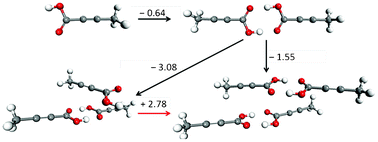The molecular self-association of carboxylic acids in solution: testing the validity of the link hypothesis using a quantum mechanical continuum solvation approach†
Abstract
According to the “link hypothesis” there is a connection between the

* Corresponding authors
a
Department of Chemistry, University College London, 20 Gordon Street, London WC1 H0AJ, United Kingdom
E-mail:
d.tommaso@ucl.ac.uk
According to the “link hypothesis” there is a connection between the

 Please wait while we load your content...
Something went wrong. Try again?
Please wait while we load your content...
Something went wrong. Try again?
D. Di Tommaso, CrystEngComm, 2013, 15, 6564 DOI: 10.1039/C3CE40539G
This article is licensed under a Creative Commons Attribution 3.0 Unported Licence. You can use material from this article in other publications without requesting further permissions from the RSC, provided that the correct acknowledgement is given.
Read more about how to correctly acknowledge RSC content.
 Fetching data from CrossRef.
Fetching data from CrossRef.
This may take some time to load.
Loading related content
